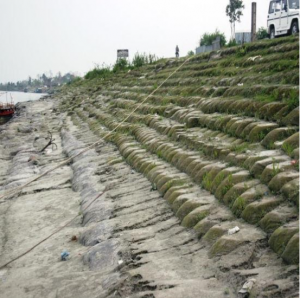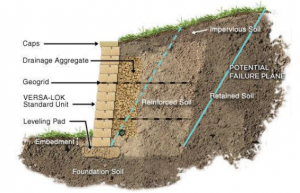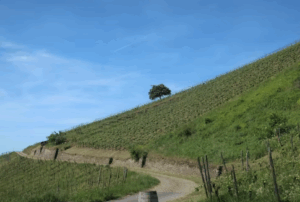Geobag for slope protection

Abstract: River bank erosion is a global issue that has become more prevalent over time as a result of increased human activities that cause channel changes. Bank erosion can be avoided by restoring the area using erosion control structures. Geotextiles are the result of the textile industry developing goods with such uses. Geobag is an example of a geotextile application. In the current project, geobags are being used to combat river bank erosion in the local area. Pre-monsoon and post-monsoon erosion assessments were conducted using slope estimates and physical measurements such as vegetation retention. The type of geobag employed, as well as the technique of installation and soil retention observations of the research area, are discussed in depth in this paper.
River Panchanganga originates in the western ghats and flows through the Kolhapur districts of Maharashtra, India. In the steep tahsils of Kolhapur district’s western section, it is produced by tributaries of five rivers: Kumbhi Kasari Bhogavati Tulsi and Dhamani. It runs 70 kilometres from Kolhapur city to the eastern side of the district, where it meets the Krishna River and enters Karnataka. The problem of river bank erosion is growing more severe these days due to encroachment for agriculture on river banks and frequent flooding. Farmers in the basin are really concerned about this. As a result, techniques of river bank protection must be implemented as soon as possible, and the effectiveness of erosion management must be assessed.
The textile business has a wide range of uses in today’s world, leading to the development of industrial textile. The invention of man-made fibres in the twentieth century revolutionised the global industrial textile business. Geotextile refers to any textile product that is used under the soil. Today, geosynthetic materials are widely employed in the geotechnical and civil engineering fields.
Non-woven geotextiles, woven geotextiles, and coir geotextiles are the three basic types of geotextile fabric. Each of these materials has its own set of characteristics that make it ideal for the applications in which it is utilised. Furthermore, each geotextile will often have a distinct weight or strength to assist fulfil both low weight and high strength needs. The non-woven geobag is comprised of technical cloth with three sides that are tightly sewn and one side that is open. It’s made to be filled with dirt and installed while maritime and hydraulic constructions are being built. Nonwoven geotextile bags, also known as geobags, are a geosynthetic product consisting of polyester, polypropylene, or polyethylene that is used to protect hydraulic structures and river banks from severe erosion and scouring.
Since the introduction of geo bags, the product has proven to be a game-changer in terms of preventing riverbank erosion and safeguarding beaches, as well as providing effective flood protection. In this essay, we’ll go through the uses and benefits of geo bags. However, before we get started, let’s define what a “geo bag” is. Geo bags are filled with sand and/or dirt and are composed of woven polyester and polypropylene fabrics. Typically, geo bags are used to construct shore-protection structures. Let’s take a look at four key applications and benefits of geo bags:
Soil Erosion Prevention on Riverbanks
Soil erosion is a major problem in nations with a significant number of rivers, such as India. Soil erosion is also a key contributor to floods, deforestation, and the extinction of flora and animals. Geo bags have played an important role in preventing soil erosion since their inception. They’ve shown to be more successful than standard riverside soil arresting approaches. Geo bags have been demonstrated in studies to assist wild animals in the forest in gaining access to water without sliding into bodies of water. Furthermore, properly avoiding soil erosion leads to greater soil retention and agricultural production in the surrounding areas.
Flood-Prevention Alternative That Isn’t Expensive
Flood-control strategies, both traditional and contemporary, have large costs, making their deployment difficult. Geo bags are an excellent alternative to such costly procedures. Many geobags manufacturers in India, such as Emmbi, produce high-quality geobags that may be used to construct sandbag barriers to redirect flood water or slow its flow. These sand-filled geo bag walls are not only more cost-effective to construct, but also considerably more convenient to do so without causing any damage to existing structures or buildings. These low-cost, simple-to-build walls may also be utilised in rainwater collecting systems, which can be employed in drought-prone areas such as Maharashtra’s Marathwada.
Ports, Dams, and Harbours Construction
Geo bags are particularly important in the building of ports, dams, harbours, and other water-related structures because they give a robust, resilient, long-lasting, and sturdy resistance to strong water flow. One of the most important aspects of not only erecting these buildings on and near waterbodies, but also keeping the waterbodies from flooding the routes of these structures, is resistance. In areas where the water current is stronger, geo bags can also be utilised to provide further protection and strength to the dock foundation.
Groynes and Breakwaters Under Scour Protection
To protect coastal regions from the power of waves, groynes and breakwaters are erected into the oceans. Over time, these structures erode, leaving them unstable and putting coastal regions at risk. Geo bags can be quite useful in securing these buildings and preventing possible dangers to coastal areas. This prolongs the life of the groynes and breakwaters, as well as providing a cost-effective option and preventing sand erosion at their bases.



